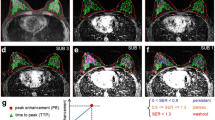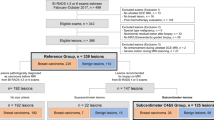Abstract
Objectives
Assessment of contrast agent kinetics in contrast-enhanced MRI (CE-MRI) with gadolinium-containing contrast agents offers the opportunity to predict breast lesion malignancy. The goal of our study was to determine if similar patterns exist for spectral contrast-enhanced digital breast tomosynthesis (CE-DBT) using an iodinated contrast agent.
Methods
The protocol of our prospective study was approved by the relevant institutional review board and the German Federal Office for Radiation Protection. All patients provided written informed consent. We included 21 women with a mean age of 62.4 years. All underwent ultrasound-guided biopsy of a suspect breast lesion, spectral CE-DBT and CE-MRI. For every breast lesion, contrast agent kinetics was assessed by signal intensity–time curves for spectral CE-DBT and CE-MRI. Statistical comparison used Cohen’s kappa and Spearman’s rho test.
Results
Spearman’s rho of 0.49 showed significant (P = 0.036) correlation regarding the contrast agent kinetics in signal intensity–time curves for spectral CE-DBT and CE-MRI. Cohen’s kappa indicated moderate agreement (kappa = 0.438).
Conclusion
There is a statistically significant correlation between contrast agent kinetics in the signal intensity–time curves for spectral CE-DBT and CE-MRI. Observing intralesional contrast agent kinetics in spectral CE-DBT may aid evaluation of malignant breast lesions.
Key Points
• Contrast agent kinetics can be assessed using spectral digital breast tomosynthesis (DBT).
• Contrast agent kinetics patterns in spectral DBT are similar to those in contrast-enhanced MRI.
• Multiple contrast enhancement for spectral DBT gives additional diagnostic information.







Similar content being viewed by others
Abbreviations
- CE-DBT:
-
contrast-enhanced DBT
- CE-MRI:
-
contrast-enhanced breast magnetic resonance imaging
- DBT:
-
digital breast tomosynthesis
- DM:
-
digital mammography
- ROI:
-
region of interest
- LE:
-
low energy
- LT:
-
total energy
References
Carney PA, Miglioretti DL, Yankaskas BC et al (2003) Individual and combined effects of age, breast density, and hormone replacement therapy use on the accuracy of screening mammography. Ann Intern Med 138:168–175
Förnvik D, Zackrisson S, Ljungberg O et al (2010) Breast tomosynthesis: accuracy of tumor measurement compared with digital mammography and ultrasonography. Acta Radiol 51:240–247
Andersson I, Ikeda DM, Zackrisson S et al (2008) Breast tomosynthesis and digital mammography: a comparison of breast cancer visibility and BIRADS classification in a population of cancers with subtle mammographic findings. Eur Radiol 18:2817–2825
Hellerhoff K (2010) Digital breast tomosynthesis: technical principles, current clinical relevance and future perspectives. Radiologe 50:991–998
Tingberg A (2010) X-ray tomosynthesis: a review of its use for breast and chest imaging. Radiat Prot Dosim 139:100–107
Lewin JM, Niklason L (2007) Advanced applications of digital mammography: tomosynthesis and contrast-enhanced digital mammography. Semin Roentgenol 42:243–252
Lee SH, Kim JH, Cho N et al (2010) Multilevel analysis of spatiotemporal association features for differentiation of tumor enhancement patterns in breast DCE-MRI. Med Phys 37:3940–3956
Yamamoto A, Fukushima H, Okamura R et al (2006) Dynamic helical CT mammography of breast cancer. Radiat Med 24:35–40
Prionas ND, Lindfors KK, Ray S et al (2010) Contrast-enhanced dedicated breast CT: initial clinical experience. Radiology 256:714–723
Diekmann F, Diekmann S, Jeunehomme F, Muller S, Hamm B, Bick U (2005) Digital mammography using iodine-based contrast media: initial clinical experience with dynamic contrast medium enhancement. Investig Radiol 40:397–404
Dromain C, Balleyguier C, Adler G, Garbay JR, Delaloge S (2009) Contrast-enhanced digital mammography. Eur J Radiol 69:34–42
Dromain C, Balleyguier C, Muller S et al (2006) Evaluation of tumor angiogenesis of breast carcinoma using contrast-enhanced digital mammography. Am J Roentgenol 187:528–537
Jong RA, Yaffe MJ, Skarpathiotakis M et al (2003) Contrast-enhanced digital mammography: initial clinical experience. Radiology 228:842–850
Schmitzberger FF, Fallenberg EM, Lawaczeck R et al (2011) Development of low-dose photon-counting contrast-enhanced tomosynthesis with spectral imaging. Radiology 259:558–564
Baltzer PA, Benndorf M, Gajda M, Kaiser WA (2010) An exception to tumour neoangiogenesis in a malignant breast-lesion. Breast J 16:197–198
Kuhl CK, Mielcareck P, Klaschik S et al (1999) Dynamic breast MR imaging: are signal intensity time course data useful for differential diagnosis of enhancing lesions? Radiology 211:101–110
Kuhl CK, Jost P, Morakkabati N, Zivanovic O, Schild HH, Gieseke J (2006) Contrast-enhanced MR imaging of the breast at 3.0 and 1.5 T in the same patients: initial experience. Radiology 239:666–676
Nunes LW, Englander SA, Charafeddine R, Schnall MD (2002) Optimal post-contrast timing of breast MR image acquisition for architectural feature analysis. J Magn Reson Imaging 16:42–50
Hylton NM (2001) Vascularity assessment of breast lesions with gadolinium-enhanced MR imaging. Magn Reson Imaging Clin N Am 9:321–332
Carton AK, Gavenonis SC, Currivan JA, Conant EF, Schnall MD, Maidment AD (2010) Dual-energy contrast-enhanced digital breast tomosynthesis–a feasibility study. Br J Radiol 83:344–350
Fredenberg E et al (2010) Energy resolution of a photon- counting silicon strip detector. Nucl Instrum Methods Phys Res A 613:156–162
Lawaczeck R, Jost G, Pietsch H (2011) Pharmacokinetics of contrast media in humans: model with circulation, distribution, and renal excretion. Investig Radiol 46:576–585
Landis JR, Koch GG (1977) The measurement of observer agreement for categorical data. Biometrics 1:159–174
Gur D, Abrams GS, Chough DM et al (2009) Digital breast tomosynthesis: observer performance study. AJR Am J Roentgenol 193:586–591
Acknowledgments
This pilot study is part and supported by the HighReX project, funded by the European Union. We acknowledge the members of the HighReX project for their contributions and assistance.
Author information
Authors and Affiliations
Corresponding author
Rights and permissions
About this article
Cite this article
Froeling, V., Diekmann, F., Renz, D.M. et al. Correlation of contrast agent kinetics between iodinated contrast-enhanced spectral tomosynthesis and gadolinium-enhanced MRI of breast lesions. Eur Radiol 23, 1528–1536 (2013). https://doi.org/10.1007/s00330-012-2742-5
Received:
Revised:
Accepted:
Published:
Issue Date:
DOI: https://doi.org/10.1007/s00330-012-2742-5




